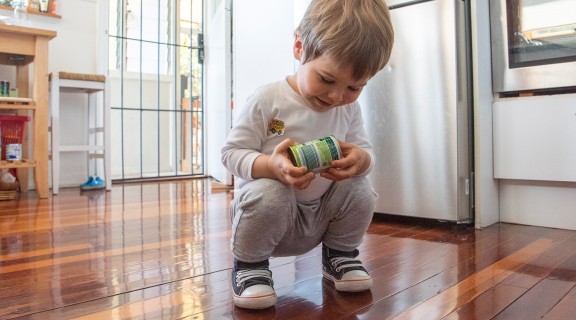
Learning with everyday objects
29 October 2019 | State Library of Queensland
Imagination doesn’t cost a cent. Simple household objects can make cheap, low-fuss toys that can help your child learn about the world around them.
Opportunities to explore
Plastic containers, food, sticks and leaves, clothes and clothes pegs can all be used to teach your child about classifying objects – an important practical skill we all need in our daily lives.
Learning about how things look the same and different is an important early skill that needs to happen before children learn to read. Noticing that letters can look the same and some are different, and knowing letter names and their sounds are essential early literacy skills that will pave the way for future reading and writing learning.
So exploring and understanding shapes, and noticing how things are similar and different in fun and playful ways is an essential stepping stone for little ones.
Give your child plenty of opportunities to explore with these ideas:
- Put a selection of objects together and ask your child to sort them into groups. Can they be arranged by colour, size, shape, texture or use? Talk with your child about how they have grouped the objects. Together, find new ways to sort them.
- When reading a picture book, point out two pictures and ask your child what is similar or different about them. Books like the ones in the Hairy Maclary series by Lynley Dodd provide great opportunities for this activity. You could ask, “What’s the same about Hairy Maclary and Schnitzel Von Krumm?” and “What's different about them?” "What’s the same or different about our dog/friend’s dog and Hairy Maclary?"
- Get help sorting the clean laundry by asking your child to make piles of different types of clothes. Talk about why you need to sort the clothes and the different ways you can do it.
- In the kitchen, compare the ingredients that go into your recipe and ask questions like, “Which fruit is heavier, the apple or the strawberry?”, “How many different coloured vegetables are in our soup?”
- Unpack the cutlery drawer and challenge your child to put everything back in its place. Talk about why you put things together that are alike (easy to find, etc.)
- When it’s time to tidy up, ask your child to help put things in piles so they can go back where they belong. For example, “Let’s put all the books together here and all the toys in the box.”
- At bathtime, test some objects to see which ones float and which ones sink. With your child, organise them into groups.
Comments
Your email address will not be published.
We welcome relevant, respectful comments.